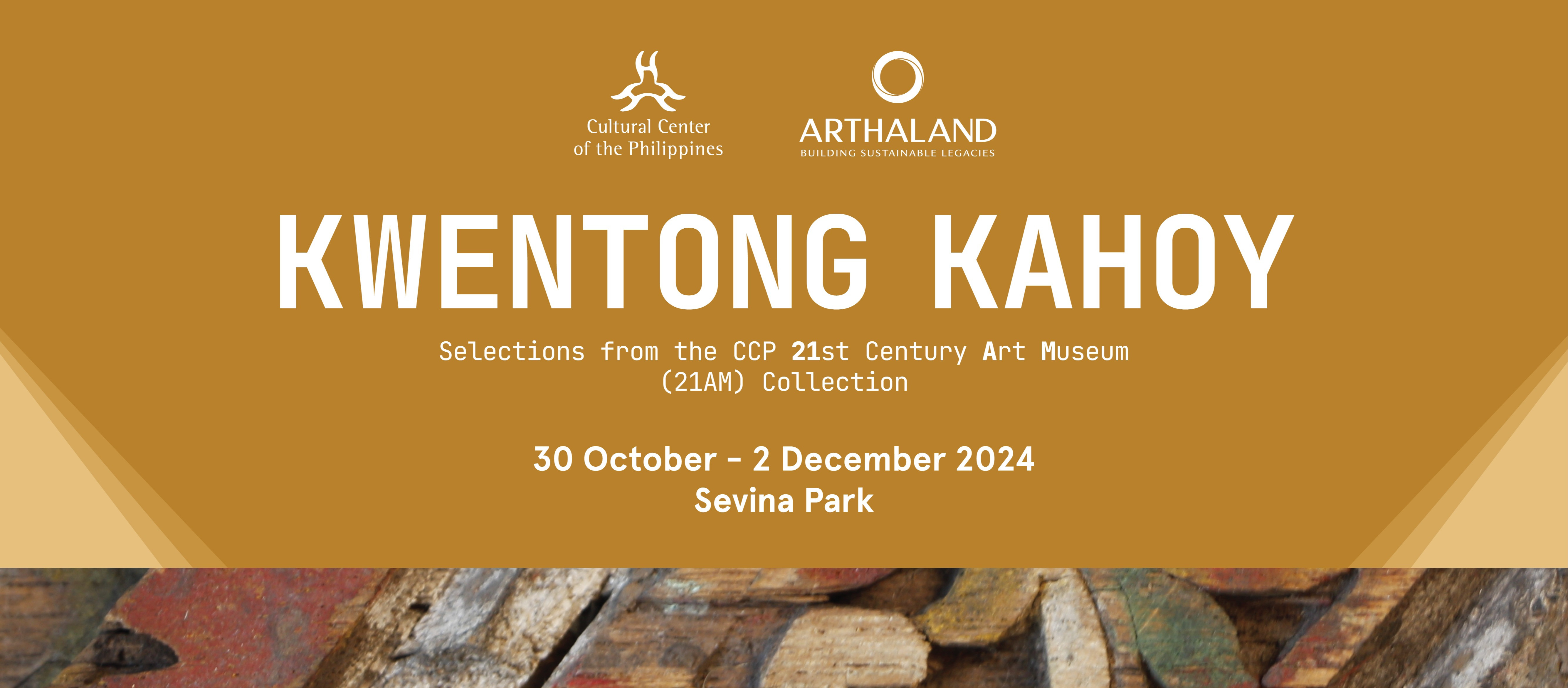
Kwentong Kahoy: Selections from the CCP 21st Century Art Museum (21AM) Collection
30 October - 2 December 2024
Kwentong Kahoy: Selections from the CCP 21st Century Art Museum (21AM) Collection re-imagines Filipino ingenuity and craftsmanship through the versatile medium of wood, as shaped and carved by the different approaches, techniques and processes utilized in traditions and art-making practices. Wood, kahoy in Filipino, is composed of hardened tissue that provides strength, and is the main conduit that distributes nutrients to the different parts of trees and other plants. It is one of the most abundant and adaptable natural materials.
This exhibit examines the relationship between function and form present within the materiality of wood from the selected artworks from the CCP 21AM Collection in five thematic categories: Wood in Music, Wood as Ceremonial Object, Wood in Play, Wood in Everyday Life, and Wood in Artistic Practice.
Wood has remained as one of the most ubiquitous mediums for its durability and unique aesthetic quality. Examples of the varied use of wood can be found throughout mankind’s history, from the smallest hunting tools to large architectural elements. As such, the use of wood in artistic expression has continually evolved and transformed through time, as forms of experimentation and innovation push the boundaries of modern and contemporary Filipino art.
Kwentong Kahoy communicates a sense of place and community wherein the material and climate conditions from which wood as medium is produced, is rooted in our connections with our cultural heritage and Filipino identity. Thus, fostering a greater appreciation for environmental consciousness towards material and the role of art in Philippine society.
Wood in music focuses on the use of wood as a material and/or component in different sound producing objects. This section presents examples of the following musical instrument classification; membranophones, chordophones, and idiophones. This classification identifies the component that vibrates and produces the sounds. In membranophones, a membrane vibrates, in chordophones, strings vibrate, and in idiophones, the entire body of the instrument vibrates. The representative instruments presented in this section are different Asian traditional instruments that the Cultural Center of the Philippines has collected through the years. It was once part of the permanent exhibition at the Museo ng Kalinangang Pilipino on the fourth floor of the CCP Main Theater building until its closure in 2017.
Wood as ceremonial objects explores the use and function of wood as ritual paraphernalia. This section shows how the use of wood by our pre-colonial ancestors has transcended and been integrated into the major religions present in the Philippines, such as Christianity and Islam. Presented are a pair of bulols, anthropomorphic figures and punamhan, a ritual box associated with indigenous ceremonies in Northern Luzon, as well as religious images such as the retablo altarpiece, a prayer book used in Christian worship, and wooden ceremonial vessels used by the Maranao.
Wood in play explores the taka (paper maché) tradition of Paete, Laguna. The taka is made with strips of newspaper soaked in starch glue, which is meticulously attached to a wooden sculptural mold called the taka’an. The wet newspaper strips are pressed against these taka’an so that the sculptural detail of the wooden mold would be impressed on the hardening strips of paper. Once it has hardened, the wrapped paper is then cut along a specific line to detach it from the mold. It is then reattached and the seam covered by strips of paper. It is then painted with vibrant colors to enhance its appeal to consumers.
Wood in everyday life highlights the versatility of this material. From its use in agriculture, hunting and food production, to its utilization in households as cutlery and wares used for food consumption, vessels for food preservation and storage. Wood also functions as an architectural component of the domicile and defines important structures, as evidenced by the panolong, an extended house beam of the torogan, the traditional residence of a Maranao sultan or datu.
The exhibition also features works from modern and contemporary Filipino artists whose creations stylistically and materially use wood as medium in two-dimensional and three-dimensional forms, as well as artworks that compound wood derivatives. It features paintings, prints, sculptures, and mixed media works. Additionally, wood in artistic practice also includes the ways in which wood is utilized as support for paintings, offering structural integrity and interesting textures to the work. Kwentong Kahoy brings together artists BenCab, Ang Kiukok, Felix Abesamis, Lee Aguinaldo, Austria Antonio, Santiago “Santi” Bose, Imelda Cajipe-Endaya, Nonoy Ferrarez, Rodolfo Gan, Rodolfo Roa, Pablo Mahinay, Soler Santos, Manuel Soriano, and Roberto Villanueva in conversation with medium.
Artworks by the following visual artists:
National Artist Ang Kiukok +
National Artist Benedicto “BenCab” Cabrera
Felix Abesamis
Lee Aguinaldo +
Antonio Austria
Santiago “Santi” Bose +
Imelda Cajipe Endaya
Nonoy Ferrarez
Rodolfo Gan
Pablo Mahinay
Rodolfo Roa
Soler Santos
Manuel Soriano +
Roberto Villanueva +
Artifacts from the following ethnolinguistic groups:
Blaan
Ibanag
Ifugao
Maranao
Palawan
Tagalog
T’boli
Traditional musical instruments from the following countries:
China
India
Indonesia
Japan
South Korea
Thailand

